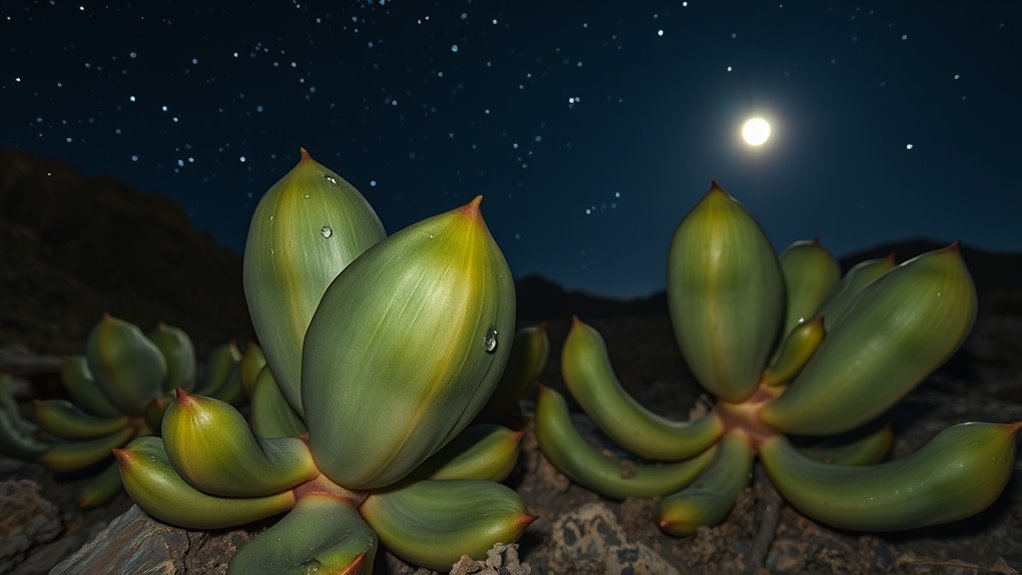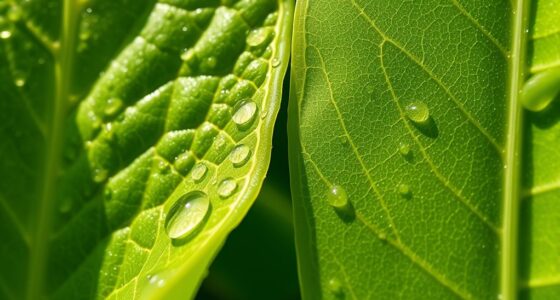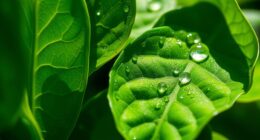CAM photosynthesis allows desert plants to breathe at night by opening their stomata during cooler, more humid hours. This helps them absorb carbon dioxide while minimizing water loss in hot, dry conditions. The plants store the CO₂ as malic acid overnight, then use it during the day for photosynthesis with their stomata closed. This clever process keeps the plants alive in harsh environments—you’ll discover more about how they thrive as you explore further.
Key Takeaways
- CAM plants open stomata at night to absorb CO₂, reducing water loss during hot daytime hours.
- During the night, CO₂ is stored as malic acid inside the plant’s cells.
- Stomata remain closed during the day, conserving moisture in arid environments.
- Malic acid is broken down during the day to release CO₂ for photosynthesis.
- This temporal separation enables desert plants to breathe and grow efficiently at night.

Have you ever wondered how some plants survive in extreme environments with scarce water? In deserts and arid regions, plants have developed unique strategies to conserve water while still conducting essential metabolic processes. One such adaptation is CAM photosynthesis, which allows these plants to breathe at night, reducing water loss during the hot daytime hours. Instead of keeping their stomata open during the day, CAM plants open them at night, a process known as stomatal regulation. This way, they minimize water vapor escape, which is critical in dry environments where every drop counts.
At night, when temperatures are cooler and humidity is higher, CAM plants open their stomata to absorb carbon dioxide. This CO₂ is then stored as organic acids, mainly malic acid, within their cells. During the day, when the sun’s intensity is highest, they close their stomata tightly to prevent water loss. Instead of taking in CO₂, they utilize the stored malic acid for carbon fixation, a process that takes place in the chloroplasts. This adaptation allows CAM plants to perform photosynthesis efficiently while conserving precious water. By separating the initial CO₂ intake and fixation in time, these plants optimize their energy use and water retention.
CAM plants open stomata at night to store CO₂ as malic acid, conserving water during hot days.
The process of carbon fixation in CAM plants is quite fascinating. At night, the absorbed CO₂ combines with phosphoenolpyruvate (PEP), a process catalyzed by the enzyme PEP carboxylase, resulting in the formation of malic acid. This acid is then stored in vacuoles until daytime. When daylight arrives, the stored malic acid is transported out of the vacuoles and broken down to release CO₂. This CO₂ is then used in the Calvin cycle to produce sugars necessary for growth and energy. This cycle allows CAM plants to maintain productivity despite limited water availability.
Stomatal regulation is the key to CAM plants’ survival. By opening their stomata at night and closing them during the day, they effectively bypass the water loss that would otherwise occur during photosynthesis in hot, dry conditions. This regulation not only conserves water but also ensures that the plant’s metabolic processes continue smoothly. Over time, this adaptation has enabled desert plants like cacti and succulents to thrive where other plants cannot survive. In essence, CAM photosynthesis is a remarkable example of nature’s ingenuity—allowing plants to breathe and grow even when water is scarce, simply by shifting their photosynthetic activities to a cooler, more humid time of day. Additionally, ongoing research into AI in Education could further enhance understanding and conservation of these unique plant adaptations.
Frequently Asked Questions
How Do CAM Plants Store Carbon Dioxide Overnight?
You see, CAM plants store carbon dioxide overnight through stomatal regulation, allowing their stomata to open at night while keeping water loss minimal. During this time, they fix carbon dioxide into organic acids like malate and store it in vacuoles. When daylight returns, the plant releases the stored CO2 for photosynthesis. This efficient process helps desert plants conserve water while still carrying out carbon fixation effectively.
Are CAM Plants More Efficient Than C3 or C4 Plants in Deserts?
Yes, CAM plants are more efficient than C3 or C4 plants in deserts because they excel at drought resistance and water conservation. They open their stomata at night to reduce water loss, storing CO₂ for daytime photosynthesis. This adaptation allows them to survive harsh, arid conditions better than other plants, making them ideal for desert environments where conserving water is vital.
Can CAM Photosynthesis Occur in Non-Desert Environments?
Yes, CAM photosynthesis can occur in non-desert environments. Remarkably, some aquatic plants use CAM to conserve water, especially in fluctuating water levels. In urban agriculture, CAM plants like succulents thrive even in limited space and water. This adaptation allows them to efficiently photosynthesize across diverse settings, making CAM a versatile strategy beyond deserts. So, whether in city gardens or aquatic habitats, CAM plants prove adaptable and resourceful.
What Environmental Factors Trigger CAM Photosynthesis in Plants?
You trigger CAM photosynthesis in plants mainly through environmental factors like water scarcity, high daytime temperatures, and intense sunlight. When water conservation becomes critical, plants switch to CAM to minimize water loss. Elevated temperatures also promote this process, aiding in temperature regulation. By opening their stomata at night, these plants optimize photosynthesis while conserving water, ensuring survival in harsh, arid conditions.
How Does CAM Photosynthesis Impact Plant Growth and Reproduction?
You’ll notice that CAM photosynthesis boosts your plant’s growth and reproduction by optimizing stomatal regulation, which reduces water loss during the day. This process enhances metabolic efficiency, allowing the plant to conserve resources while still producing energy. As a result, your plant can thrive in arid environments, reproduce successfully, and grow healthier over time, even with limited water availability.
Conclusion
As you explore CAM photosynthesis, you see how desert plants master the art of breathing in the silence of night, like quiet warriors cloaked in darkness. They draw in life’s breath when the world is still, transforming it into vibrant energy by dawn’s first light. Their nighttime dance with the stars is a delicate, intricate ballet—a silent affirmation to resilience and ingenuity in the harshest of worlds, reminding you that even in adversity, life finds a way to flourish.










